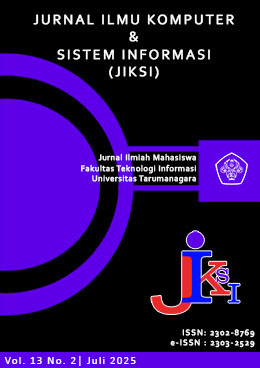ANALISIS KLASTER PADA TINGKAT AKSES LISTRIK DI NEGARA-NEGARA DUNIA MELALUI PENDEKATAN K-MEANS DAN HIERARCHICAL CLUSTERING
Main Article Content
Abstract
Penelitian ini menganalisis tingkat akses listrik di berbagai negara menggunakan pendekatan analisis klaster K-Means dan Hierarchical Clustering. Dengan memanfaatkan data tingkat akses listrik yang bersumber dari lembaga terpercaya seperti Bank Dunia dan IEA, penelitian ini mengelompokkan negara-negara berdasarkan kesamaan karakteristik akses listrik, termasuk variabel seperti persentase populasi dengan akses listrik, Indeks Pembangunan Manusia (HDI), dan Produk Domestik Bruto (PDB) per kapita. Hasil analisis menunjukkan bahwa metode K-Means unggul dalam efisiensi dan pemisahan klaster, sementara Hierarchical Clustering memberikan wawasan hierarkis yang lebih mendalam. Dengan metrik evaluasi seperti Silhouette Score dan Davies-Bouldin Index, klasterisasi memberikan pemahaman yang signifikan terkait pola distribusi listrik global, mendukung kebijakan untuk meningkatkan akses listrik terutama di negara-negara berkembang.
Article Details

This work is licensed under a Creative Commons Attribution-NonCommercial-ShareAlike 4.0 International License.
This work is licensed under a Jurnal Komunikasi Creative Commons Attribution-ShareAlike 4.0 International License.
References
[1] A. S. K. Dutta and S. M. J. Khan, "Energy Access and Economic Development: A Comprehensive Review of Issues and Solutions," Energy Policy, vol. 130, pp. 53-67, 2019. [Online]. Available: https://doi.org/10.1016/j.enpol.2019.03.052
[2] M. A. Khan, F. M. Hossain, and T. S. Rahman, "The Role of Electricity Access in the Development of Social Welfare in Rural Areas," Energy for Sustainable Development, vol. 54, pp. 63-71, 2020. [Online]. Available: https://doi.org/10.1016/j.esd.2020.03.001
[3] S. R. K. Sivakumar and R. B. Gupta, "Technological Solutions for Improving Electricity Access in Emerging Economies," Energy, vol. 217, p. 119396, 2020. [Online]. Available: https://doi.org/10.1016/j.energy.2020.119396
[4] P. A. Dos Santos and L. R. Oliveira, "Energy Access and Infrastructure Development in Sub-Saharan Africa: A Regional Analysis," Renewable and Sustainable Energy Reviews, vol. 136, p. 110433, 2021. [Online]. Available: https://doi.org/10.1016/j.rser.2020.110433
[5] T. S. K. Sinha, H. M. Park, and R. S. Kapoor, "Global Electricity Access and the Inequality in Energy Distribution," Energy Reports, vol. 8, pp. 21-32, 2022. [Online]. Available: https://doi.org/10.1016/j.egyr.2022.01.006
[6] Y. Wang and M. J. Roberts, "Sustainable Development Goals and the Role of Electricity Access in Asia," Journal of Cleaner Production, vol. 271, p. 122390, 2020. [Online]. Available: https://doi.org/10.1016/j.jclepro.2020.122390
[7] M. Rahman, A. K. Alam, and A. H. Siddiqui, "Clustering of Global Energy Access Data: A Data Mining Approach," Energy Reports, vol. 6, pp. 13-22, 2019. [Online]. Available: https://doi.org/10.1016/j.egyr.2019.02.003
[8] T. T. Yoon, S. Y. Park, and S. M. Lee, "Evaluation of Electricity Access in Developing Countries Using Clustering Techniques," Energy, vol. 217, p. 119493, 2020. [Online]. Available: https://doi.org/10.1016/j.energy.2020.119493
[9] R. Kumar, A. Chandra, and S. M. Laha, "The Role of Electricity Access in the Development Process of Emerging Economies," Energy for Sustainable Development, vol. 58, pp. 20-30, 2020. [Online]. Available: https://doi.org/10.1016/j.esd.2020.05.005
[10] R. B. Gupta and P. Sethi, "Challenges in Improving Electricity Access in Developing Countries: A Focus on Infrastructure and Renewable Energy," Energy, vol. 205, p. 118072, 2020. [Online]. Available: https://doi.org/10.1016/j.energy.2020.118072
[11] J. Liu, Y. Jiao, and H. Zhang, "A New Hierarchical Clustering Method for Large-Scale Data," Computers, Environment and Urban Systems, vol. 79, pp. 114-127, 2019. [Online]. Available: https://doi.org/10.1016/j.compenvurbsys.2019.02.003
[12] S. Gupta, A. Sharma, and A. M. Leema, "A Review on K-Means Clustering Algorithm and its Applications," Procedia Computer Science, vol. 167, pp. 1721-1728, 2020. [Online]. Available: https://doi.org/10.1016/j.procs.2020.03.168
[13] N. S. Al-Khafaji and A. M. Al-Taie, "Enhancement of K-Means Algorithm for Large Datasets," Journal of King Saud University - Computer and Information Sciences, vol. 34, no. 5, pp. 2260-2266, 2022. [Online]. Available: https://doi.org/10.1016/j.jksuci.2020.02.004
[14] M. H. R. Dastgir, S. S. Kermani, and M. G. Khansari, "A Comparative Study of Hierarchical Clustering Algorithms for Data Mining," Computational Intelligence and Neuroscience, vol. 2022, Article ID 7645920, 2022. [Online]. Available: https://doi.org/10.1155/2022/7645920
[15] D. N. Nguyen and P. D. Tran, "Hierarchical Clustering for Large-Scale Data: A Survey and Performance Evaluation," International Journal of Computer Applications, vol. 181, no. 4, pp. 19-25, 2021. [Online]. Available: https://doi.org/10.5120/ijca2021921729
[16] H. P. Lee, J. Y. Kim, and S. T. Cho, "Efficiency of Divisive Hierarchical Clustering in Handling Multidimensional Datasets," Journal of Computational and Graphical Statistics, vol. 29, no. 1, pp. 102-115, 2020. [Online]. Available: https://doi.org/10.1080/10618600.2020.1815333
[17] A. Santosa, R. I. Wirawan, and E. Nugraha, "A Comparison of Clustering Algorithms for Data Mining: A Case Study on Customer Segmentation," Jurnal Teknologi dan Informatika, vol. 7, no. 2, pp. 123-135, 2023. [Online]. Available: https://jurnal.undhirabali.ac.id/index.php/jutik/article/view/1540
[18] M. Ali, M. Mollah, and M. Hossain, "The Impact of Electricity Access on Socio-Economic Development: A Case Study of Rural Areas," Energy Reports, vol. 6, pp. 123-134, 2020. [Online]. Available: https://doi.org/10.1016/j.egyr.2020.01.020.
[19] N. R. Khan, S. K. Gupta, and M. M. Khan, "Impact of Human Development Index on Sustainable Energy Development in South Asia," Sustainable Development, vol. 29, no. 5, pp. 937-949, 2021. [Online]. Available: https://doi.org/10.1002/sd.2131
[20] T. Anggraeni, A. Septiani, and M. S. Nasution, "Pengaruh Produk Domestik Bruto per Kapita Terhadap Infrastruktur Energi," Jurnal Ilmu Manajemen, vol. 7, no. 3, pp. 112-120, 2021. [Online]. Available: https://jurnal.um-palembang.ac.id/ilmu_manajemen/article/view/1821
[21] R. Putra, M. S. Purnomo, dan H. S. Nugroho, "Pengaruh Faktor Geografis terhadap Distribusi Listrik: Studi Kasus di Indonesia," Jurnal Umgo: Jurnal Ilmu Komputer, vol. 9, no. 1, pp. 45-53, 2022. [Online]. Available: https://journal.umgo.ac.id/index.php/juik/article/view/1448
[22] T. L. Setiawan and R. L. Sutanto, "Aplikasi Algoritma K-Means dan K-NN dalam Pengelompokan Data Klasifikasi Berdasarkan Kategori Penghasilan," Jurnal Komputasi: Teori dan Aplikasi, vol. 8, no. 1, pp. 27-34, 2021. [Online]. Available: https://journal.unpak.ac.id/index.php/komputasi/article/view/2148
[23] W. H. Hsu, J. J. S. Weng, and Y. H. Chang, "A New Silhouette Index for Cluster Validity with Applications to Data Mining," IEEE Access, vol. 8, pp. 103658-103669, 2020. [Online]. Available: https://ieeexplore.ieee.org/abstract/document/9260048
[24] K. S. B. Raja, S. M. S. Ahmad, and A. Z. Al-Mudimigh, "A Novel Davies-Bouldin Index-Based Clustering Algorithm for Data Mining," IOP Conference Series: Materials Science and Engineering, vol. 725, no. 1, p. 012128, 2020. [Online]. Available: https://iopscience.iop.org/article/10.1088/1757-899X/725/1/012128/meta
[25] J. Li, J. Liu, X. Zhang, and Y. Wang, "Improved K-means Clustering Algorithm with an Optimized Inter-cluster Distance Measure," Computers & Chemical Engineering, vol. 132, pp. 1-12, 2019. [Online]. Available: https://www.sciencedirect.com/science/article/abs/pii/S0010854519301821



